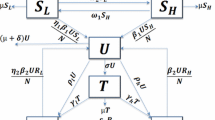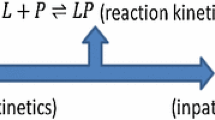Abstract
Adolescence methamphetamine use is an issue of considerable concern due to its correlation with later delinquency, divorce, unemployment and health problems. Understanding how adolescents initiate methamphetamine abuse is important in developing effective prevention programs. We formulate a mathematical model for the spread of methamphetamine abuse using nonlinear ordinary differential equations. It is assumed that susceptibles are recruited into methamphetamine use through imitation. An epidemic threshold value, \({\mathcal {R}}_a\), termed the abuse reproduction number, is proposed and defined herein in the drug-using context. The model is shown to exhibit the phenomenon of backward bifurcation. This means that methamphetamine problems may persist in the population even if \({\mathcal {R}}_a\) is less than one. Sensitivity analysis of \({\mathcal {R}}_a\) was performed to determine the relative importance of different parameters in methamphetamine abuse initiation. The model is then fitted to data on methamphetamine users less than 20 years old reporting methamphetamine as their primary substance of abuse in the treatment centres of Cape Town and parameter values that give the best fit are chosen. Results show that the proportion of methamphetamine users less than 20 years old reporting methamphetamine as their primary substance of abuse will continue to decrease in Cape Town of South Africa. The results suggest that intervention programs targeted at reducing adolescence methamphetamine abuse, are positively impacting methamphetamine abuse.




Similar content being viewed by others
References
Alkhudhari Z, Al-Sheikh S, Al-Tuwairqi S (2014) Global dynamics of a mathematical model on smoking. Hindawi Publishing Corporation, ISRN Applied Mathematics. doi:10.1155/2014/847075
Bauch CT (2005) Imitation dynamics predict vaccinating behaviour. Proc R B Soc 272:16691675. doi:10.1098/rspb.2005.3153
Benedict B (2007) Modeling alcoholism as a contagious disease: how infected drinking buddies spread problem drinking. SIAM News 40(3):11–13
Birkhoff G, Rota G (1982) Ordinary differential equations. needham Heights Ginn 39:251–257
Bissell JJ, Caiado CCS, Goldstein M, Straughan B (2014) Compartmental modelling of social dynamics with generalised peer incidence. Math Models Methods Appl Sci 24:719–750
Brook JS, Morojele NK, Brook DW, Rosen Z (2005) Predictors of cigarette use among South African adolescents. Int J Behav Med 12(4):207–217
Brook JS, Morojele NK, Pahl T, Brook D (2006) Predictors of drug use among South African adolescents. J Adolesc Health 38(1):26–34
Buonomo B, Lacitignola D (2008) On the dynamics of an SEIR epidemic model with a convex incidence rate. Ricerche di Matematica 57:261281
Buonomo B, Lacitignola D (2014) Modeling peer influence effects on the spread of highrisk alcohol consumption behavior. Ricerche di Matematica 63:101–117
Buonomo B, Rionero S (2010) On the Lyapunov stability for SIRS epidemicmodels with general nonlinear incidence rate. Appl Math Comput 217:40104016
Capistrna MA, Morelesa MA, Larab B (2009) Parameter estimation of some epidemic models. The case of recurrent epidemics caused by respiratory syncytial virus. Bull Math Biol. doi:10.1007/s11538-009-9429-3
Capone F, De Cataldis V, De Luca R (2013) On the nonlinear stability of an epidemic SEIR reaction diffusion model. Ricerche di Matematica 62:161181
Castillo-Chavez C, Huang W (2002) Age-structure core group model and its impact on STD dynamics. In: Mathematical approaches for emerging and reemerging infectious diseases: models, methods and theory. Castillo-Chavez C, Blower SM, van den Driessche P, Kirschner D, Yakubu AA (eds) IMA 126. Springer, New York, pp 261–274
Castillo-Chavez C, Song B (2004) Dynamical models of tuberclosis and their applications. Math Biosci Eng 1(2):361–404
Chitnis N, Hyman JM, Cushing JM (2008) Determining important parameters in the spread of malaria through the sensitivity analysis of a mathematical model. Bull Math Biol 70:1272–1296
Diekmann O, Heesterbeek JAP (2000) Mathematical epidemiology of infectious diseases. Wiley, New York
Feng Z, Castillo-Chavez C, Capurro AF (2000) A model for tuberculosis with exogenous reinfection. Theor Popul Biol 57:235–247
Feng Fu, Rosenbloom DI, Wang L, Nowak MA (2011) Imitation dynamics of vaccination behaviour on social networks. Proc R B Soc 278:4249. doi:10.1098/rspb.2010.1107
Glantz MD (1992) A developmental psychopathology model of drug abuse vulnerability.In: Glantz M, Pickens R (eds) Vulnerability to drug abuse. American Psychological Association, Washington, DC
Hadeler KP, Castillo-Chavez C (1995) A core group model for disease transmission. J Math Biosci 128:4155
Hsier YH, Wang YS (2006) Basic reproduction number for HIV model incorporating commercial sex and behavior change. Bull Math Biol 68:551–575
Huang W, Cook KL, Castillo-Chavez C (1992) Stability and bifurcation for a multiple-group model for the dynamics of HIV/AIDS transmission. SIAM J Appl Math 52(3):835854
Jamison DT, Feachmen RG, Makgoba MW, Bos ER, Baingana FK, Hofman KJ, Rogo KO (2006) Disease and mortality in sub-Saharan Africa, 2nd edn. World Bank, Washington, DC
Jin Y, Wang W, Xiao S (2007) A SIRS model with a nonlinear incidence. Chaos Solitons Fract 34:14821497
Kandel DB, Davies M, Karus D, Yamaguchi K (1986) The consequences in young adulthood of adolescent drug involvement. Arch Gen Psychiatry 43:746–754
Kodaira JY, de Souza Passos JR (2010) The basic reproduction number in SI staged progression model: a probabilistic approach. In: Dynamics days South America 2010 international conference on chaos and nonlinear dynamics
Kribs-Zaleta CM, Velasco-Hernandez JX (2001) A simple vaccination model with multiple endemic states. Math Biosci 164(2):183201
Li MY, Muldowney JS (1996) A geometric approach to global stability problems. SIAM J Math Anal 27(4):1070–1083
Mastroberardino T (2014) Mathematical modeling of the HIV/AIDS epidemic in Cuba. AMS Eastern Sectional Meeting University of Maryland, Baltimore County
Morojele N, Parry C, Brook J, Kekwaletswe C (2013) Alcohol and drug use. Alcohol and Drug Abuse Research Unit, Medical Research Council, South Africa
Mubayi A, Greenwood PE, Castillo-Chavez C, Gruenewald PJ, Gorman DM (2010) The impact of relative residence times on the distribution of heavy drinkers in highly distinct environments. Soc Econ Plan Sci 44:4556
Mulone G, Straughan B (2009) A note on heroin epidemics. Math Biosci 208:138–141
Mulone G, Straughan B (2012) Modelling binge drinking. Int J Biomath 5: Article ID 1250005
Mushanyu J, Nyabadza F, Muchatibaya G, Stewart AGR (2015a) Modelling multiple relapses in drug epidemics. Ricerche di matematica. doi:10.1007/s11587-015-0241-0
Mushanyu J, Nyabadza F, Stewart AGR (2015b) Modelling the trends of inpatient and outpatient rehabilitation for methamphetamine in the Western Cape province of South Africa. BMC Res Notes 8:797. doi:10.1186/s13104-015-1741-4
Ndeffo Mbah ML, Liu J, Bauch CT, Tekel YI, Medlock J et al (2012) The impact of imitation on vaccination behavior in social contact networks. PLoS Comput Biol. doi:10.1371/journal.pcbi.1002469
Njagarah JBH, Nyabadza F (2013) Modelling the impact of rehabilitation, amelioration and relapse on the prevalence of drug epidemics. J Biol Syst 21:Article ID 1350001
Nyabadza F, Hove-Musekwa SD (2010) From heroin epidemics to methamphetamine epidemics: modelling substance abuse in a South African Province. Math Biosci 225:132–140
Nyabadza F, Njagarah JBH, Smith RJ (2012) Modelling the dynamics of crystal meth (Tik) abuse in the presence of drug-supply chains in South Africa. Bull Math Biol. doi:10.1007/s11538-012-9790-5
Onya EH (2005) A qualitative study of home-brewed alcohol use among adolescents in Mankweng District, Limpopo Province, South Africa. In: Madu NS, Govender S (eds) Mental health and psychotherapy in Africa. UL Press of the University of Limpopo Turfloop Campus, Sovenga, pp 291–307
Parry CDH, Morojele NK, Saban A, Flisher AJ (2004) Brief report: social and neighbourhood correlates of adolescent drunkenness: a pilot study in Cape Town, South Africa. J Adolesc 27(3):369–374
Pluddemann A, Myers BJ, Parry CDH (2008a) Surge in treatment admissions related to methamphetamine use in Cape Town, South Africa: implications for public health. Drug Alcohol Rev 27:185–189
Pluddemann A, Flisher AJ, Mathews C, Carney T, Lombard C (2008b) Adolescent methamphetamine use and sexual risk behaviour in secondary school students in Cape Town, South Africa. Drug Alcohol Rev 27:687–692. doi:10.1080/09595230802245253
Pluddemann A, Flisher AJ, McKetin R, Parry C, Lombard C (2010) Methamphetamine use, aggressive behavior and other mental health issues among high-school students in Cape Town, South Africa. Drug Alcohol Depend 109:14–19. doi:10.1016/j.drugalcdep.2009.11.021
Pluddemann A, Dada S, Parry CDH (2013a) Decline in adolescent treatment admissions for methamphetamine use in Cape Town. S Afr Med J 103(7):478–480. doi:10.7196/SAMJ.6529
Pluddemann A, Dada S, Parry CDH, Kader R, Parker JS, Temmingh H, van Heerden S, de Clercq C, Lewis I (2013b) Monitoring the prevalence of methamphetamine-related presentations at psychiatric hospitals in Cape Town, South Africa. Afr J Psychiatry 16:45–49
Reddy P, Resnicow K, Omardien R, Kambaran N (2007) Prevalence and correlates of substance use among high school students in South Africa and the United States. Am J Public Health 97(10):1859–1864
Reddy P, James S, Sewpaul R et al (2008) Umthente Uhlaba Usamila—the South African Youth Risk Behaviour Survey. Medical Research Council, Cape Town
Robins LN, Przybeck TR (1985) Age of onset of drug use as a factor in drug and other disorders. In: Jones CL, Battjes RJ (eds) Efiology of drug abuse: implications for prevention. National Institute on Drug Abuse, Rockville, pp 178–192
Sànchez F, Wang X, Castillo-Chavez C, Gorman DM, Gruenewald PJ (2007) Drinking as an epidemic: a simple mathematical model with recovery and relapse. In: Alan Marlatt G, Witkiewitz K (eds) Therapists guide to evidence-based relapse prevention. Academic Press, New York, p 353
Sharma S, Samanta GP (2015) Analysis of a drinking epidemic model. Int J Dyn Control. doi:10.1007/s40435-015-0151-8
Sharomi O, Gumel AB (2008) Curtailing smoking dynamics: a mathematical modeling approach. Appl Math Comput 195:475499
The South African Community Epidemiology Network on Drug Use (SACENDU) (2015). http://www.mrc.ac.za/adarg/sacendu.htm
van den Driessche P, Watmough J (2000) A simple SIS epidemic model with a backward bifurcation. J Math Biol 40:525540
van den Driessche P, Watmough J (2002) Reproduction numbers and sub-threshold endemic equilibria for the compartmental models of disease transmission. Math Biosci 180:29–48
van den Driessche P, Watmough J (2003) Epidemic solutions and endemic catastrophes. In: Dynamical systems and their applications in biology, Cape Breton Island, NS, 2001. Fields Inst Commun 36:247–257; American Mathematical Society Providence
van den Driessche P, Zou X (2007) Modeling relapse in infectious diseases. Math Biosci 207:89103
Walters CE, Straughan B, Kendal JR (2013) Modelling alcohol problems: total recovery. Ricerche Mater 62:33–53
White E, Comiskey C (2007) Heroin epidemics, treatment and ODE modelling. Math Biosci 208:312–324
Acknowledgements
The authors would like to thank the anonymous referees for their helpful comments and suggestions. J. Mushanyu, G. Muchatibaya and A.G.R. Stewart authors acknowledge, with thanks, the support of the Department of Mathematics, University of Zimbabwe. J. Mushanyu acknowledges financial support for his Doctor of Philosophy studies from the Deutscher Akademischer Austausch Dienst (DAAD) in-country scholarship. F. Nyabadza acknowledges with gratitude the support from National Research Foundation and Stellenbosch University for the production of this manuscript.
Author information
Authors and Affiliations
Corresponding author
Additional information
This work will be part of J. Mushanyu’s Doctor of Philosophy thesis.
Rights and permissions
About this article
Cite this article
Mushanyu, J., Nyabadza, F., Muchatibaya, G. et al. On the Role of Imitation on Adolescence Methamphetamine Abuse Dynamics. Acta Biotheor 65, 37–61 (2017). https://doi.org/10.1007/s10441-016-9302-3
Received:
Accepted:
Published:
Issue Date:
DOI: https://doi.org/10.1007/s10441-016-9302-3




